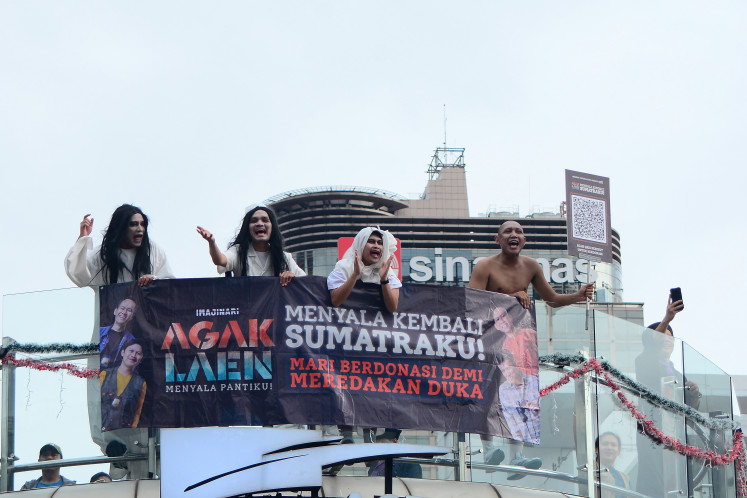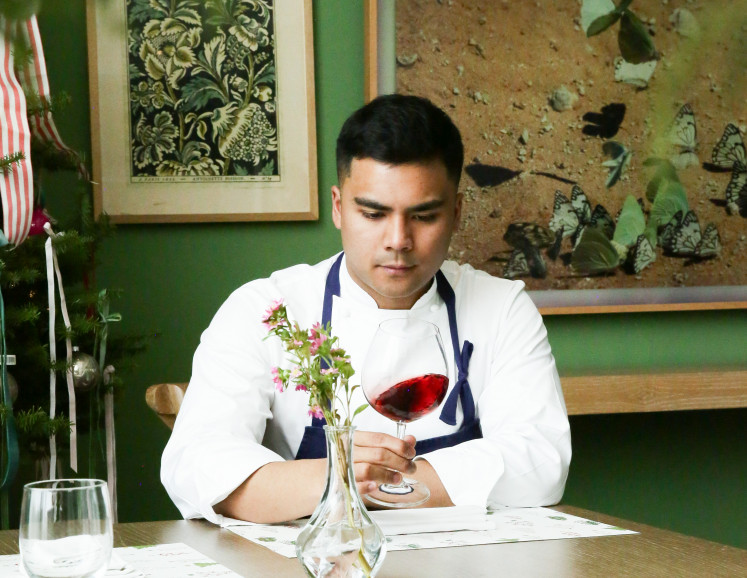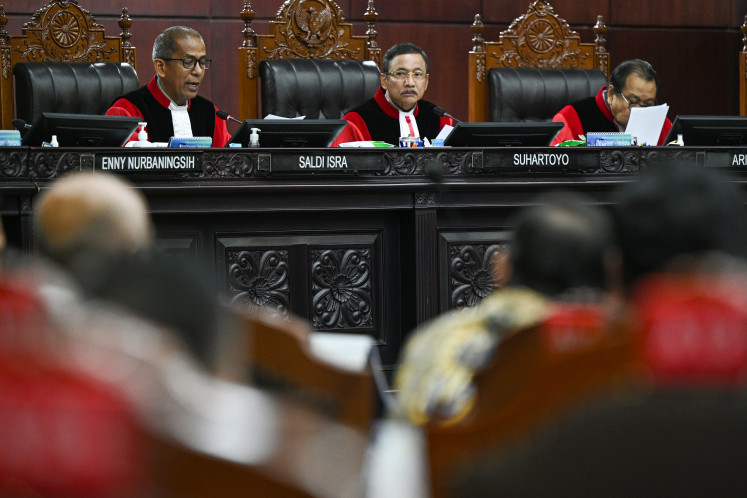Popular Reads
Top Results
Can't find what you're looking for?
View all search resultsPopular Reads
Top Results
Can't find what you're looking for?
View all search resultsArt Jakarta 2019 grows to become one of Southeast Asia's most significant art fairs
Change text size
Gift Premium Articles
to Anyone
T
he 11th edition of Indonesia’s most significant art fair Art Jakarta ran from Aug. 30 to Sept. 1 at the Jakarta Convention Center (JCC). By all accounts from gallerists, exhibiting artists, attendees and the fair organizers themselves, outcomes exceeded expectations.
Following on from the demise of Art Stage Jakarta in 2017 and Art Stage Singapore in 2018, Art Jakarta has strategically positioned itself, filling the void and consolidating itself as one of Southeast Asia’s most important art fairs. Featuring 70 galleries from 14 countries – Hong Kong, Japan, South Korea, Singapore, Indonesia, Malaysia, the United States, Taiwan, Russia, Australia, Thailand, Philippines, Vietnam and China – the fair enjoyed strong sales with more than 39,000 visitors over the three days.
From Indonesia, 30 of the country’s established and emerging galleries participated, including Edwin’s Gallery, RUCI Art Space, Lawangwangi, CGartspace, Bale Projects, SAL Projects and ART_UNLTD by BEKRAF, a presentation of 51 emerging and established artists from different backgrounds, initiated by the Creative Economy Agency (Bekraf) and curators Asmujo J. Irianto, Bob Edrian, Irawan Karseno and Totot Indrarto.
A few of the international gallery participants were Amy Li Gallery (Beijing), Flowers Gallery (London/New York/Hong Kong), Mizuma Gallery (Tokyo/Singapore/New York), Yavuz Gallery (Singapore) and Bluerider ART from Taipei. Thirty percent of the 70 participating galleries made their debut at Art Jakarta, reflecting the brand’s strong reputation and potential. Auction house Phillips Asia was among the new exhibitors, displaying artworks, watches and jewelry.
“Due to the uncertain political environment of the past few years, there has been a subdued market response to the fair,” stated Edwin Rahardjo, founder of Edwin’s Gallery and the head of the Indonesian Association of Art Galleries (AGSI). “This year, however, we have had a more stable political and economic climate in Indonesia, which has led to a renewed energy. I could feel that the audience was much more positive and upbeat. The increased activity by young local collectors was noticeable.”
Art Jakarta reported several new buyers acquiring art pieces for the first time as well as renewed interest and purchases from buyers who had been inactive for some time. New international collectors were also spotted at the fair, expanding Art Jakarta’s collector base. Collectors attending the fair hailed from throughout Southeast Asia and the Asia region, Europe, the United States and Australia.
Commenting upon the relocation of Art Jakarta from the Ritz-Carlton Jakarta in Pacific Place to the JCC in Senayan, Rahardjo said, “The JCC has many practical advantages over the previous venue, including being larger. It allows for much easier loading and unloading of artworks, and offers positive tax incentives for international galleries.”
Australian-based Indonesian artist Jumaadi works from his Yogyakarta and Sydney studios and was represented at Art Jakarta by Jan Manton Art from Brisbane, Australia. His exhibition of thematic and aesthetically distinct works stood out among the competition. Jumaadi's feedback was also positive, “We have previously participated in Australian and Southeast Asian fairs. However, this is the first experience for both Jan Manton and I at Art Jakarta and it was amazing. Comparatively speaking, this fair is no worse off or better off than the others. It is very dynamic, and the number of people during the opening was astonishing. The response to my work was strong, and we are very optimistic about the future of Art Jakarta," he said
Read also: Art Jakarta 2019 displays gigantic artworks, offers more programs
“The move from Pacific Place means that the audience is art-focused and not shopping mall visitors looking for alternative entertainment,” said Kemal Ezedine, a regular participant at Art Jakarta, who exhibited paintings with Jakarta’s CGartspace. “I believe that Art Jakarta is now stepping up to the next level.”
“Art Jakarta is an essential meeting place,” said Suriawati Qui, cofounder of CushCush Gallery in Denpasar, Bali. “Such interactions between the national and international art communities open up opportunities for important issues and conversations to be raised, opportunities for artists and galleries to get to know their peers from across the region and encourages cross-cultural and cross border collaborations.”
“As an international gallery, we have always enjoyed participating in Art Jakarta and connecting with the Indonesian art community,” said Audrey Yeo, owner/producer of Yeo Workshop, Gillman Barracks Singapore. “The fair allows us to market our artists and programs with familiar faces and new networks. With its rejuvenated format and the new venue, there was a general sense of enthusiasm from the audience and the galleries. Art Jakarta is currently very promising as one of the strongest regional fairs. The fair has good organizers with a solid working style.”
“Although small, Art Jakarta was fascinating and featured some good work. One aspect I especially liked was the smaller booths representing art collectives and artist initiatives,” said Ian Findlay-Brown, editor and publisher of Asia Art News based in Hong Kong. As one of the region’s first art magazines in the English language, and one of the most knowledgeable writers in the Asia region with over 40 years of experience, Findlay-Brown has witnessed the major changes in the Southeast Asian art scene during the past 30 years.
Commenting on “Jakarta Scene”, a designated space in the fair for artist collectives and artist initiatives that offered many diverse artworks, art products and objects, along with valuable information about their activities, that are a cornerstone of Indonesia’s dynamic art scene, Findlay-Brown stated, “You don’t often see this aspect of a local art scene represented in an art fair in the Asia region. It reveals an important facet of the vitality of the local art world that can often be missed or overlooked.”
“Their array of art products, clothing, toys and sculptures emphasizes an important fun aspect of the art world. The fair directors, by inviting these dynamic young individuals and collectives, highlight a fundamental and vibrant characteristic of the Indonesian contemporary art world.”
“The strength of the Indonesian art scene has always been its ‘gotong-royong’ or community spirit. This has lent Art Jakarta its special Indonesian identity which translates into a very unique fair experience for our visitors, exhibitors and partners,” said Art Jakarta fair director Tom Tandio. “It is only by working together that we can strengthen the art scenes in both Indonesia and Southeast Asia, which will benefit the community as a whole.”
“We were very humbled by the positive response that we received as it is a measure of the confidence that Indonesia and the region’s art community has placed in Art Jakarta, and the changes that we implemented for this 11th edition of the fair.” (wng)











